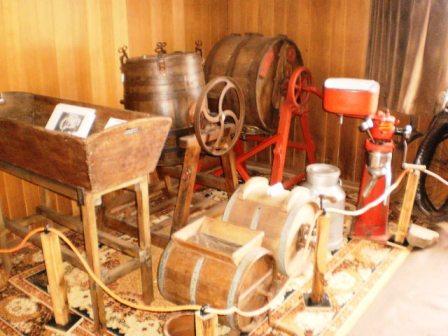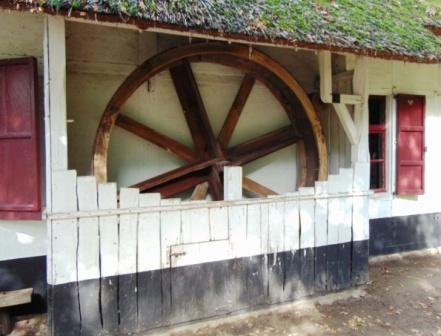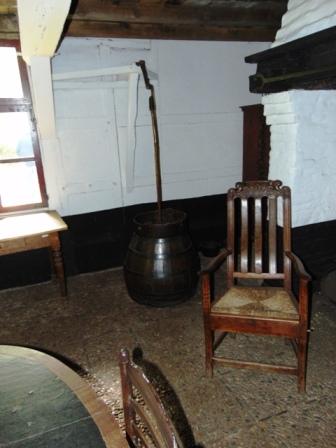 Butter is made from (whipped) cream with 35-42% fat.
Butter is made from (whipped) cream with 35-42% fat.
To make 1 kg of butter 22 to 27 liters of milk are needed. A liter cream of cow's milk provides about 200 grams of butter. A liter cream of sheep milk provides 400 grams of butter!
If you use raw milk, heat it first to 90⁰C.
The fat in milk is concentrated by sifting the surface: skimming. The milk fats have a lower density than water .They come spontaneously to the surface.
The concentrated milk fat (cream) is then churned : this is the beating of the cream. By beating them the fat particles stick more together and you get butter and buttermilk.
Work at 12° to 17° degrees. If after 30 minutes you still don’t see butter, the cream was probably too cold. Then add a little bit of warm water and continue shaking, stirring or stamping.
 Churning happened earlier in a high, possibly upward tapered wooden bowl with lid. Trough this moved a put pestle with a perforated plate. There are also swing, shake and twist barrels for churning.
Churning happened earlier in a high, possibly upward tapered wooden bowl with lid. Trough this moved a put pestle with a perforated plate. There are also swing, shake and twist barrels for churning.
With a dog wheel you can drive a churn. In 1.5 hours a dog thus churned milk into butter, while a man was working three hours at the same amount.
Knead the butter (between 2 boards) to get all water out. You can salts it to keep it longer.
Fresh leaf of rhubarb was sometimes used to pack fresh butter. The edges were held together with a wooden peg.
 Clarified butter is butter melted to separate the solid components and water from the fat. Clarified butter has a higher boiling point than ordinary butter and is used in some cooking applications.
Clarified butter is butter melted to separate the solid components and water from the fat. Clarified butter has a higher boiling point than ordinary butter and is used in some cooking applications.
Butter: or "real butter": churned cream cow's milk, with at least 82% milk fat.
Cold store butter: prolonged refrigerated butter therefore not be called butter.
‘And concerning the whole debate about butter and margarine, I trust cows a lot more than chemists.’(Joan Gussow)
Emperor Napoleon III (nephew of his more famous uncle Napoleon Bonaparte) commissioned to develop a bread spread that soldiers could carry on a campaign in their knapsack, and that does not spoil quickly.
Margarine is artificial butter, the first was made of beef fat, skim milk, and chopped cow udders. In 1869 the French chemist Hippolyte Mège-Mouriès won Napoleons production with a mixture of palmitic acid and stearic acid. From 1902 were liquid (vegetable) oils transformed into solid fats (and thus also emerged harmful trans fats). (In cooking margarine, still both vegetable and animal fats are used.)
Margarine is a factory and chemically manufactured product, more complex and less natural than butter. The story that margarine is but one molecule different from paint or plastic is wrong. The molecule has the same atoms (carbon, hydrogen and oxygen), but that is true for a multitude of products (for a bigger part including people). The molecular composition looks more like butter than like plastic.
There is still worked on this surrogate with fancy words on the label (trans fats, Omega 3 (alpha-linolenic acid) and 6 (linoleic acid), cholesterol-influencing substances, vitamins added, "halvarines' and light versions) to make it seem healthier. The production of margarine was later part of the founding of the Unilever group.
There is evidence (not proof) that this stuff is not as healthy. But as is true for any inquiry: who pays the piper. The long shelf life without infestation by fungi, insects, and without structural change feeds the plastic idea.
The name comes from the Greek margarites: pearl, because the pearly sheen of the gray goo which is colored butter yellow afterwards.
If you use it, do it in moderation. But that goes for butter al well.
‘If you stand on the butter mountain of the EU you can see without binoculars really complete Ethiopia. Starving.’ (Youp Van’t Hek)
The hardness of the butter is in direct proportion to the softness of the bread.
